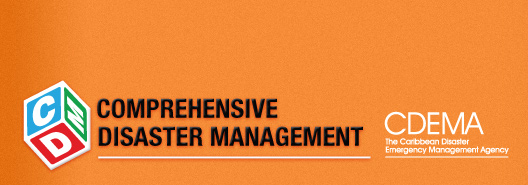
| Hurricanes & Tropical Storms |
|
Definition A hurricane is a tropical cyclone where the maximum average wind speed near its centre (eye) is more than 74 mph or 119 Km/h. The winds rotate in a counter-clockwise spiral motion around a region of low pressure. The hurricane is one of the most damaging and potentially deadly disasters which can affect the Caribbean. How are they made? A hurricane must be over water to form. They are created over warm, tropically heated water, usually near the equator. This usually happens during the hurricane season, which lasts from June to November each year. To understand what it takes to make a hurricane, we must first understand how the earth’s atmosphere works. As air gets closer to the ground it gets warmer. Over oceans, this warm, moist, low pressure air will rise and condensate, to form clouds and rain. Condensation releases heat, which warms the cool air at the top and causes that to rise as well. When this cool air rises, it is replaced by the warm air that came from below. This transfer of heat causes circling winds to rotate about a centre – like water going down a drain. The heat is the fuel for a hurricane. There are four phases in a hurricane’s development. Hurricanes usually start off as tropical disturbances and then as the intensity of the winds increases, they’re upgraded – so to speak – to tropical depressions (winds less than 38 mph), tropical storms (winds between 38 mph & 74 mph) and finally hurricanes (winds more than 74 mph). After the disturbance becomes a hurricane, it can be upgraded even further. There are different categories of hurricanes (1 through 5) which are changed as the winds grow stronger. This scale is called the Saffir Simpson Scale and can be seen below:
Issues As they move ashore, hurricanes and tropical storms bring with them a storm surge of ocean water along the coastline as well as high winds, torrential rains, and flooding. High winds and heavy rains are probably the most deadly characteristics of the storm. Heavy rains can cause floods, landslides and mudslides, while strong winds can destroy crops and homes. Like any disaster, the worst thing about a hurricane is the damage it leaves behind. Physical Damage Crops and Food Supplies Casualties and Public Health Lack of Communication History Hurricane Janet September 1955 Where? After it formed to the east of the Lesser Antilles, it quickly became a small hurricane and hit Aftermath? Janet reduced many cities to rubble. It claimed 32 lives in Barbados, damaged 8,100 homes Hurricane Gilbert September 1988 Where? Gilbert passed directly over Jamaica – it was the first hurricane to do so since 1951. After Aftermath? Gilbert claimed 318 lives: 202 in Mexico, 45 in Jamaica, 30 in Haiti, 12 in Guatemala, 5 in Hurricane Ivan September 2004 Where? It moved through the extreme Southern Windward Islands of Barbados and Grenada as a category 4 hurricane. It destroyed 75 to 90 percent of all buildings on the island of Grenada. As it moved into the ocean, it strengthened to category 5 status before making landfall near Aftermath? Ivan was responsible for an estimated 110 deaths throughout the Caribbean and the |
|
Looking for:
|











